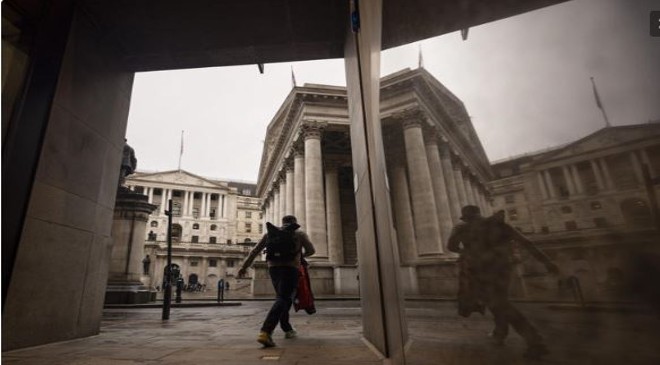The astonishing political demise of British Prime Minister Liz Truss shows what can happen when ambitious plans collide with a new financial market reality that places the fight against inflation above all else.
Truss resigned Thursday after just 45 days in office, a casualty of the market turmoil triggered by her plans to increase government borrowing and cut taxes despite an annual inflation rate above 10 percent.
The Truss implosion was fueled by distinctly British considerations. But the market upheaval — which at one point saw investors judge Britain a worse credit risk than notoriously profligate Italy — ignited unexpected difficulties in British pension funds and started a search for the next financial domino that could topple as interest rates climb.
Bond mutual funds, pensions, corporate debt and government finances all are being scrutinized for hidden weak spots, analysts said, as the Federal Reserve continues raising interest rates at the fastest pace in 40 years. Investors expect the central bank to lift rates several times in the coming months in a bid to cool off rising consumer prices, including at its next meeting in November.
“The Fed will just keep hiking until something breaks,” said Eric Robertsen, global head of research and chief strategist for Standard Chartered Bank in Dubai. “I think it’s more likely that there will be a financial market crack before there’s an economic crack.”
After years of easy money policies, the Fed is leading central banks in tightening credit to battle painfully high inflation. Interest rates have moved sharply higher in the United States, United Kingdom, Europe, Canada and dozens of smaller countries in the broadest such campaign to hit the global economy in a quarter-century.
Bond market volatility this month hit its highest level since early March 2020, when the Fed was forced to step in to buy $1 trillion in U.S. treasury securities. Sluggish trading in treasuries — normally the most liquid market on Earth — now has Treasury Secretary Janet L. Yellen considering buying back some government securities from traders to ease market functioning.

The markets’ grinding gears do not mean an imminent financial crisis, analysts said. But the friction illustrates the bumpy transition that the global economy is making from more than a decade of ultralow interest rates to an era of more costly credit. With the Fed promising months of additional interest rate hikes, more market volatility is likely.
Globally, stocks have lost roughly $30 trillion in value so far this year while bonds have suffered one of their worst years ever.
The financial reset is occurring as international risks are multiplying, with the war in Ukraine and the souring of U.S.-China relations roiling markets.
Unpredictable linkages between finance and geopolitics have flared in earlier eras, such as in 1998 when the hedge fund Long-Term Capital Management collapsed during the Russian financial crisis, requiring a U.S. government-led bailout.
“There is a risk of a disorderly tightening of financial conditions that may be amplified by vulnerabilities built over the years,” the International Monetary Fund warned this month in a report, which said financial stability risks had grown since April and are “significantly skewed to the downside.”
For more than a decade, while interest rates were low and the Fed actively purchased government and mortgage securities, it was easy for investors to sell most assets.
Now as the Fed and other central banks tighten monetary policy, normally liquid markets are becoming more congested. Investors who want to unload, say, a Treasury bond, encounter delays or wide gaps between their asking price and what buyers will pay.
Since securities backed by the U.S. government are regarded as risk-free, their price is the key to determining the value of other financial assets. So problems buying and selling treasuries can infect other markets.
“Liquidity has been papering over weaknesses in other markets, and now we’ll see what they are. And we’ll see it in a bunch of assets,” said Megan Greene, global chief economist for the Kroll Institute.
In the United Kingdom, while Truss took a beating for delivering a risky economic plan that had not been vetted by independent analysts, British pension funds became the center of the crisis.

Many fund managers had banked on a strategy called liability-driven investing, or LDI, designed to allow pensions to earn higher returns during the low-rate era that followed the 2007-2008 financial crisis. With LDI, fund managers basically would lend bonds in return for cash that they would reinvest to boost returns.
When yields spiked on British government bonds, the funds were forced to quickly raise cash to make up the difference between the original value of the bonds they had pledged and their current lower price.
The fastest way to raise money was to sell government bonds. But that set off a vicious cycle: Falling bond prices meant demands for more collateral, which required more bond sales, pushing prices down even more.
“These are the sort of things we saw in the financial crisis, and that’s something to be worried about,” John Waldron, president and chief operating officer of Goldman Sachs, told an industry group this month. “We don’t know what the next risk is that will move the market.”
Indeed, fresh trouble elsewhere could ricochet from market to market.
For example, corporations with weak credit ratings could be downgraded to junk status, which would force some portfolio managers to sell their bonds, Greene said.
As those corporate bonds sink in value, other investors who bought them with borrowed money might face sudden demands for repayment. To raise money to meet those “margin calls,” they would sell other assets, triggering a price decline there, too.
Corporations that are poor credit risks already are finding it harder to raise money in the bond market. Issuance of new high-yield, or “junk,” bonds so far this year is down three-quarters from the same period last year, according to the Securities Industry and Financial Market Association (SIFMA.)
But only 19 percent of the corporate debt that must be refinanced by the end of next year is junk, according to Torsten Slok, chief economist of Apollo Global Management.
“The amount to be refinanced is quite manageable. The question is: How long do interest rates stay at high levels?” Slok said.
If rates stay high, companies and governments alike would feel a serious pinch.
During previous episodes of market turmoil, the Fed often intervened to effectively stanch the bleeding. In March 2020, as stock prices collapsed and trading in treasury securities seized up, the Fed cut its benchmark lending rate to near zero and added more than $4 trillion in securities to its balance sheet.
But with inflation now stubbornly high, the Fed will probably be unable or unwilling to cut rates or flood markets with cash, analysts said.
“We’re in an unparalleled hiking cycle globally. … I’m more nervous about the system breaking because the Fed backstop is just not there,” said Priya Misra, head of global rates strategy for TD Securities.
In the wake of the U.K. debacle, higher interest rates are already shadowing government finances. Heavily indebted countries like Italy, despite rising energy costs, may have to reduce their borrowing plans. Already, 19 developing countries must pay 10 percentage points above the roughly 4 percent that the U.S. government now pays investors to borrow for 10 years, according to the U.N. Development Program.

Government bond markets may have become more vulnerable to shocks over the past decade, according to a new report from the Financial Stability Board, a global advisory panel.
Trading in the U.S. treasury market is less liquid than at any time since April 2020, according to one Bloomberg gauge.
The market jam is the result of the sharp increase in the volume of government debt securities coupled with the impact of post-financial crisis regulations, intended to make banks safer, but which also have made banks less willing to store treasuries on their own books while they look for a buyer.
The $23.7 trillion in treasuries outstanding is up more than $7 trillion since the end of 2019, according to the SIFMA, reflecting the cost of fighting the pandemic and supporting the economy.
At the same time, regulations enacted after the financial crisis require banks to hold more capital in reserve to cover potential losses on securities they own.
The Fed also has stopped reinvesting the funds it receives from maturing securities, which some investors say has hurt demand for treasuries.
Treasury this month surveyed traders on whether they supported a potential program for the government to repurchase some securities and, if so, how it should be structured.





























